May 23rd, 2011 |
Published in
error cards
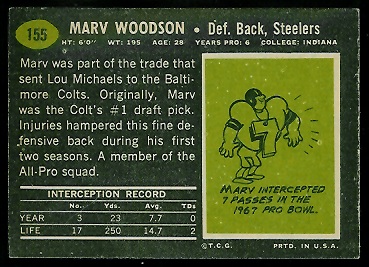 I was looking at some 1969 Topps cards today, and I ran across this Marv Woodson card. When I read the cartoon on the back, I thought, wow, now that has to be a record! So I did a search for the 1967 Pro Bowl, and I found a nice article about it. The article, it turned out, didn’t support the cartoon; it said Woodson’s team, the NFL East, had a total of four interceptions in the game. I then checked Woodson’s page at pro-football-reference.com and got the real story: Woodson had seven interceptions during the 1967 season, and he also made the Pro Bowl that year. The cartoonist sort of contracted those two accomplishments.
I was looking at some 1969 Topps cards today, and I ran across this Marv Woodson card. When I read the cartoon on the back, I thought, wow, now that has to be a record! So I did a search for the 1967 Pro Bowl, and I found a nice article about it. The article, it turned out, didn’t support the cartoon; it said Woodson’s team, the NFL East, had a total of four interceptions in the game. I then checked Woodson’s page at pro-football-reference.com and got the real story: Woodson had seven interceptions during the 1967 season, and he also made the Pro Bowl that year. The cartoonist sort of contracted those two accomplishments.
Though I don’t often look at the cartoons, this is the second big error I have found in a cartoon on a Topps card. The other was on Homer Jones’s 1968 Topps card, which said that “Homer Defeated the Russians in the 1960 Olympics.” As I wrote in an earlier blog post, Jones never competed in the Olympics.
So now I’m skeptical: Did Butch Byrd really love to read detective stories in his spare time? Did Roy Jefferson really dabble in investments after football season? Did Ron McDole really play paddle-racquets to stay in condition? I’ll check my facts before quoting the cartoonist!
April 7th, 2011 |
Published in
error cards, New in the Gallery, Oddball
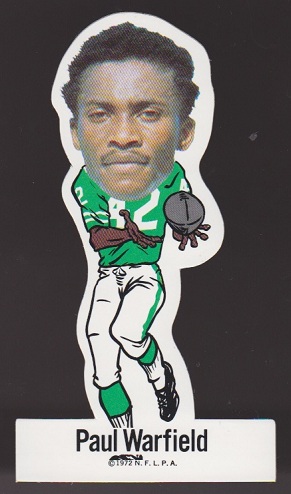 Yesterday I added 1972 NFLPA Vinyl Stickers to the Vintage Football Card Gallery. A number of places on the web say that the stickers were sold from vending machines, but I couldn’t find a picture of such a machine. I was a little surprised at that. The stickers are bigger than standard-sized cards, and I’m curious about how they were packaged for vending.
Yesterday I added 1972 NFLPA Vinyl Stickers to the Vintage Football Card Gallery. A number of places on the web say that the stickers were sold from vending machines, but I couldn’t find a picture of such a machine. I was a little surprised at that. The stickers are bigger than standard-sized cards, and I’m curious about how they were packaged for vending.
There are twenty players in the set of stickers, with two variations. The Joe Namath and Dick Butkus stickers each come two ways: with a reversed image of the player’s head, and with the player’s head oriented correctly. To guess which stickers had the reversed images, I compared them to the images on 1972 NFLPA Iron Ons.
I can’t say I am fond of these stickers. The big-real-head-on-little-cartoon-body design also appears on other cards–1938 Goudey baseball cards, for example–and I have always found it a bit creepy. Also, the stickers don’t include the players’ teams, and some don’t even have the players in the correct team colors. Paul Warfield in green and John Brockington in purple? That must have alarmed young Dolphins and Packers fans!
For more oddball football cards and collectibles, see the Oddball page of the Vintage Football Card Gallery.
November 24th, 2010 |
Published in
error cards
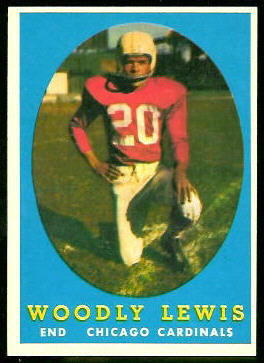 Woodley Lewis appeared on three Topps football cards, and Topps spelled his name differently on all three. In 1958, he was Woodly. In 1959, he was Woody. In 1960, Topps finally got it right and spelled his name Woodley. The card companies misspelled plenty of players’ names (see a previous blog article, E is for Error Cards), but I can’t think of another player who had his name spelled three different ways.
Woodley Lewis appeared on three Topps football cards, and Topps spelled his name differently on all three. In 1958, he was Woodly. In 1959, he was Woody. In 1960, Topps finally got it right and spelled his name Woodley. The card companies misspelled plenty of players’ names (see a previous blog article, E is for Error Cards), but I can’t think of another player who had his name spelled three different ways.
As I usually do when I write about a player, I did a little web search for Lewis, and I turned up a couple of nice non-card images. One, on the University of Oregon web site, pictures him in the middle of a broad jump. Another, on flickr, shows him in front of the Sportsman Bowl, a bowling alley that he owned after retiring from football. I also found an old matchbook for Woodley Lewis’s Sportsman Bowl on eBay.
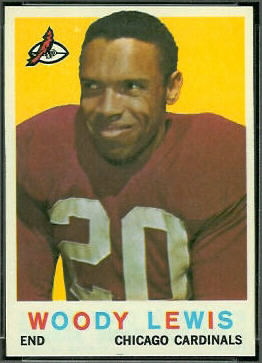
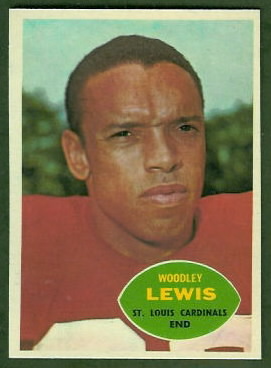
November 9th, 2010 |
Published in
Brothers, error cards
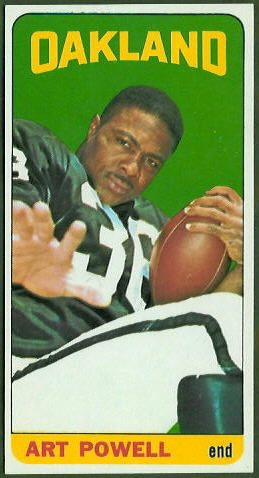 In an article a couple of weeks ago, I wrote that Rick Redman’s 1965 Topps card doesn’t picture Rick Redman. In a comment on that article, my friend Todd, from whom I learned about the Redman error, pointed out that Art Powell’s 1965 Topps card pictures the wrong player, too. So I added that card to my Mistaken Identities page, as well. Somehow, I don’t think it will be the last one.
In an article a couple of weeks ago, I wrote that Rick Redman’s 1965 Topps card doesn’t picture Rick Redman. In a comment on that article, my friend Todd, from whom I learned about the Redman error, pointed out that Art Powell’s 1965 Topps card pictures the wrong player, too. So I added that card to my Mistaken Identities page, as well. Somehow, I don’t think it will be the last one.
Todd, in his own blog, recently wrote a nice article about Art Powell and his older brother Charlie. Charlie Powell played for the 49ers and Raiders, and he was a world-class boxer, to boot. Check it out!
You can see all of Art Powell’s cards and all of Charlie Powell’s cards in the Vintage Football Card Gallery. You can also search for all of the error cards–or at least the ones I have identified so far.
October 28th, 2010 |
Published in
error cards, New in the Gallery, Sites I Like
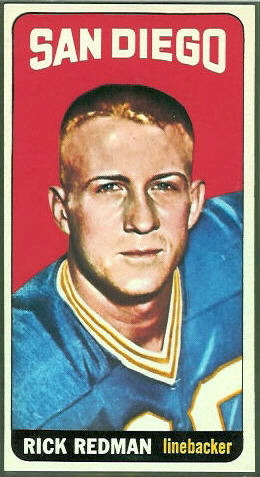 I learned from Todd Tobias’s new blog, Tales from the American Football League, that Rick Redman’s rookie card, the 1965 Topps card shown here, does not picture Rick Redman. So, if it’s not Rick Redman, who is it? Well, Todd has a nice story to tell about it, so I’ll direct you to his article.
I learned from Todd Tobias’s new blog, Tales from the American Football League, that Rick Redman’s rookie card, the 1965 Topps card shown here, does not picture Rick Redman. So, if it’s not Rick Redman, who is it? Well, Todd has a nice story to tell about it, so I’ll direct you to his article.
A surprising number of vintage football cards picture the wrong player. I keep a list of them, and Mr. Redman’s card is just the latest addition. You can see all of them on my Mistaken Identities page.
September 30th, 2010 |
Published in
error cards, Interesting eBay Auctions
There are two cards on eBay this week that I seldom see for sale: a 1955 Topps All-American Whizzer White card with Gaynell Tinsley’s bio, and a Gaynell Tinsley card with Whizzer White’s bio. Both were graded 8, or NM/MT, by PSA. It apparently didn’t take Topps long to correct their error in 1955, because these two cards are much scarcer than the corrected versions. The back of each error card is shown here.
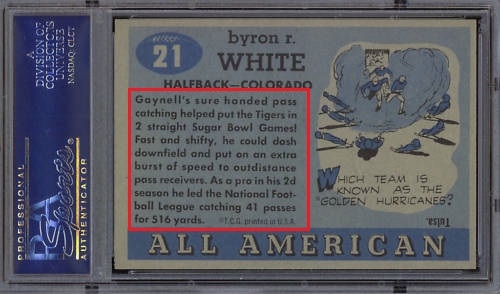
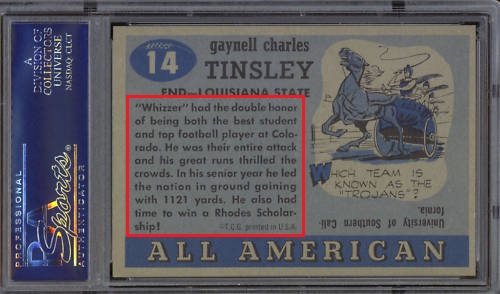
Years ago, when I first read about these errors, I assumed that the backs of the cards were swapped in their entirety. Wrong-back cards are fairly common; you can see a few of them on my 1960 Fleer virtual uncut sheet page. It was only recently that I learned that only the bio sections of the White and Tinsley cards are swapped. This is why the descriptions in the price guides say Gaynell Tinsley (Whizzer White bio) and Whizzer White (Gaynell Tinsley bio). Duh.
I have always thought that the corrected Whizzer White card was undervalued, considering that it is his rookie card, and that he served as a U.S. Supreme Court justice for 31 years after his football career. White’s card sells for only about double the price of a common in the 1955 All-American set, and the price guides put it at two or three times the price of a common. His error card sells for much more, but that is because of its scarcity, not his fame.
For more on the 1955 Topps All-American set, see A is for All-Americans.
May 11th, 2010 |
Published in
error cards, New in the Gallery, Uniforms
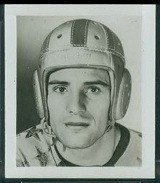 Yesterday I added 1948 Kellogg’s Pep football cards to the Vintage Football Card Gallery. The five cards are part of a 42-card sport and entertainment set that was distributed in boxes of Kellogg’s Pep cereal. You can see the composition of the set on PSA’s web site, but you have to look in two places, since PSA split the set into athletes and celebrities. Apparently not many trading card sets contain both.
Yesterday I added 1948 Kellogg’s Pep football cards to the Vintage Football Card Gallery. The five cards are part of a 42-card sport and entertainment set that was distributed in boxes of Kellogg’s Pep cereal. You can see the composition of the set on PSA’s web site, but you have to look in two places, since PSA split the set into athletes and celebrities. Apparently not many trading card sets contain both.
The cards are small, about half the height of a standard trading card. There is one variation among the football cards: some instances of Charley Trippi’s card have the image reversed, and some have it corrected. The Trippi card shown here has the reversed image, though I’m not sure how to tell. Perhaps by how his chinstrap is fastened?
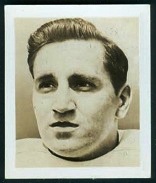 Trippi’s card shows him in his College All-Star uniform–note the stars on the shoulders. He played in the game five times: four as a college all-star, and one as a Chicago Cardinal, after the Cardinals won the 1947 NFL championship. The College All-Star Game site has a photo of Trippi in action in 1945, the year he was the All-Stars’ MVP.
Trippi’s card shows him in his College All-Star uniform–note the stars on the shoulders. He played in the game five times: four as a college all-star, and one as a Chicago Cardinal, after the Cardinals won the 1947 NFL championship. The College All-Star Game site has a photo of Trippi in action in 1945, the year he was the All-Stars’ MVP.
Another notable card in the 1948 Pep set is a Lou Groza pre-rookie card, pictured here. Groza’s rookie card is a 1950 Bowman. Check out my pre-rookie card page for more pre-rookies.
April 29th, 2010 |
Published in
error cards
I mentioned in F is for Fleer that the logo is reversed on every one of the 1961 Fleer Green Bay Packers cards. Fleer didn’t employ any geography majors, apparently. Other than the logo problem, the cards are great. It appears that all of the photos except Bill Forester’s were taken on the same day, since the players are all wearing the same sweater, and most of the images show the stadium in the background.
Here are a few of them, all Hall of Famers. You can see the whole 1961 Fleer Packers team set in the Vintage Football Card Gallery. (Incidentally, some collectors consider the Jim Taylor card pictured here and his 1961 Topps card to be his true rookie cards, since his 1959 and 1960 Topps cards picture another Jim Taylor.)
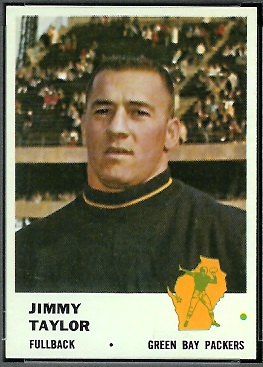
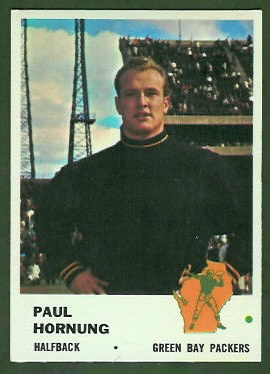
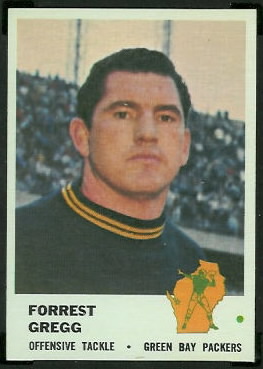
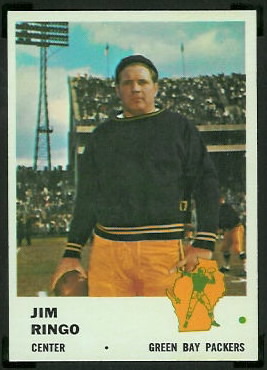
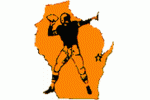 Here is the Packers logo in its correct orientation, with Green Bay and Door County in the east, from Chris Creamer’s sportslogos.net. Later variations of the logo, such as the one on the 1967 Philadelphia Packers insignia card, had dots on the little Wisconsin map for both Green Bay and Milwaukee, since the Packers played home games in both cities.
Here is the Packers logo in its correct orientation, with Green Bay and Door County in the east, from Chris Creamer’s sportslogos.net. Later variations of the logo, such as the one on the 1967 Philadelphia Packers insignia card, had dots on the little Wisconsin map for both Green Bay and Milwaukee, since the Packers played home games in both cities.
March 6th, 2010 |
Published in
ABCs of Vintage Football Cards, error cards, General Collecting Info, Interesting Message Board Threads
Occasionally you will see uncut sheets of vintage cards up for sale. Studying uncut sheets can give you insight into why some cards are much harder to find than others. For example, by looking at the uncut sheets for a set, you can see why some cards are considered short prints or double prints. For most sets, the price guides indicate which cards are short prints or double prints, and they adjust the cards’ prices accordingly. I say most, because some short prints are not documented–those in the 1964-1967 Philadelphia sets, for instance.
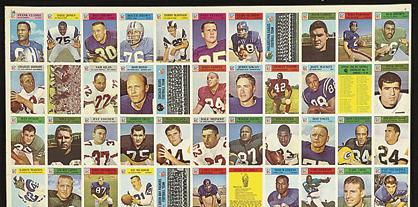
(Image from legendaryauctions.com; click on it to see whole sheet.)
Short prints and double prints are just part of the story. A card’s position on an uncut sheet can also affect its scarcity, because cards on the corners and edges of the sheets were more likely to be damaged in production. I have not seen this factored into price guides’ prices, though: if two common cards were printed in equal numbers, the price guides will usually–if not always–assign them the same price.
The price guides do assign higher prices to the first and last cards in a set, asserting that the first and last cards generally got more wear than the other cards. Supposedly, lots of kids sorted their cards into numerical order, put rubber bands around them, and banged them around. In practice, though, I find that first and last cards aren’t noticeably scarcer in high grades than the other cards, unless they happened to be on the corners and edges of the sheets.
A recent–and timely!–thread in the Collectors Universe forums includes pictures of numerous uncut baseball card sheets and a nice discussion about short prints and double prints. The thread shows the patterns that the card companies used when arranging cards from sets of different sizes on the sheets. Depending on the size of the set (or series within a set), the card companies repeated rows of cards on the sheets in different patterns. I recommend reading the thread.
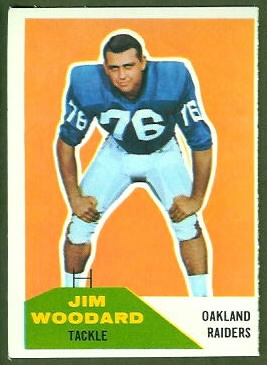 Pictured here is the card I always use as an example of one that is scarce because of its position on the sheet. It’s a 1960 Fleer Jim Woodard card, and it was in the bottom-left corner of the sheet. The Woodard is easily the toughest card in the set–PSA has graded only four of them 7 or better–and a PSA 8 would sell for hundreds of dollars on eBay. Most other PSA 8 1960 Fleer commons sell for $10-20.
Pictured here is the card I always use as an example of one that is scarce because of its position on the sheet. It’s a 1960 Fleer Jim Woodard card, and it was in the bottom-left corner of the sheet. The Woodard is easily the toughest card in the set–PSA has graded only four of them 7 or better–and a PSA 8 would sell for hundreds of dollars on eBay. Most other PSA 8 1960 Fleer commons sell for $10-20.
Over the past year, I have put together a number of “virtual” uncut sheets in the Vintage Football Card Gallery, including one for the 1960 Fleer set. I have included a little discussion for each sheet, as well. Rather than repeat the information here, I’ll just point you to the pages for the sheets:
Here are more of the ABCs:
February 19th, 2010 |
Published in
CFL Cards, error cards
It is well-known among vintage football card collectors that the 1959 Topps rookie card of the Packers’ Jim Taylor pictures a different Jim Taylor. And so does his 1960 Topps card. (For pictures of them, see my Mistaken Identities page.) I didn’t know until recently, though, that the other Jim Taylor–Jim G. Taylor–appeared on a card of his own. Here he is, with the Hamilton Tiger-Cats, on a 1961 Topps CFL card. Thanks to Pastor Scott for calling my attention to it. (Click on the card to see a bigger image.)
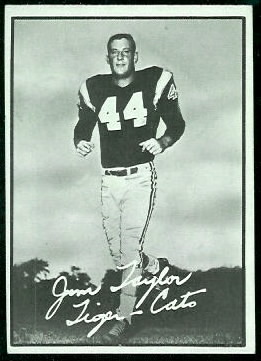
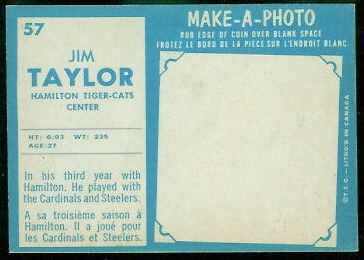 Jim G. Taylor, according to his page on pro-football-reference.com, played for Pittsburgh in 1956, and for the Chicago Cardinals in 1957 and 1958. According to the Hamilton Tiger-Cats’ all-time roster, by the time Jim G. appeared on Jim C.’s card in 1959, he had left the Cardinals and was playing for Hamilton. By 1961, when Topps issued his CFL card, he had left the Tiger-Cats, too. Topps couldn’t seem to catch up with the guy!
Jim G. Taylor, according to his page on pro-football-reference.com, played for Pittsburgh in 1956, and for the Chicago Cardinals in 1957 and 1958. According to the Hamilton Tiger-Cats’ all-time roster, by the time Jim G. appeared on Jim C.’s card in 1959, he had left the Cardinals and was playing for Hamilton. By 1961, when Topps issued his CFL card, he had left the Tiger-Cats, too. Topps couldn’t seem to catch up with the guy!
As you can see, the fronts of the 1961 Topps CFL cards look nothing like the 1961 Topps NFL/AFL cards, but the backs are nearly the same. As I have seen on other CFL cards, the short text on the back is in both English and French, which requires it to be even shorter than usual. The CFL cards (judging by this one) do not have College or Years Pro fields on them, as the 1961 Topps NFL/AFL cards do.
At first I thought that the facsimile signature on the front of the 1961 CFL cards was a nice touch, but it turns out that the signatures on all of the cards are in the same handwriting. You can see many more examples on eBay.
It would be fun to collect CFL cards, but I’m learning that there are a ton of them, and I have my hands full with the NFL and AFL. Maybe I’ll just start picking up cards of CFL players who also played in the U.S. It’s interesting to see how the players moved between the leagues.
 I was looking at some 1969 Topps cards today, and I ran across this Marv Woodson card. When I read the cartoon on the back, I thought, wow, now that has to be a record! So I did a search for the 1967 Pro Bowl, and I found a nice article about it. The article, it turned out, didn’t support the cartoon; it said Woodson’s team, the NFL East, had a total of four interceptions in the game. I then checked Woodson’s page at pro-football-reference.com and got the real story: Woodson had seven interceptions during the 1967 season, and he also made the Pro Bowl that year. The cartoonist sort of contracted those two accomplishments.
I was looking at some 1969 Topps cards today, and I ran across this Marv Woodson card. When I read the cartoon on the back, I thought, wow, now that has to be a record! So I did a search for the 1967 Pro Bowl, and I found a nice article about it. The article, it turned out, didn’t support the cartoon; it said Woodson’s team, the NFL East, had a total of four interceptions in the game. I then checked Woodson’s page at pro-football-reference.com and got the real story: Woodson had seven interceptions during the 1967 season, and he also made the Pro Bowl that year. The cartoonist sort of contracted those two accomplishments.


















